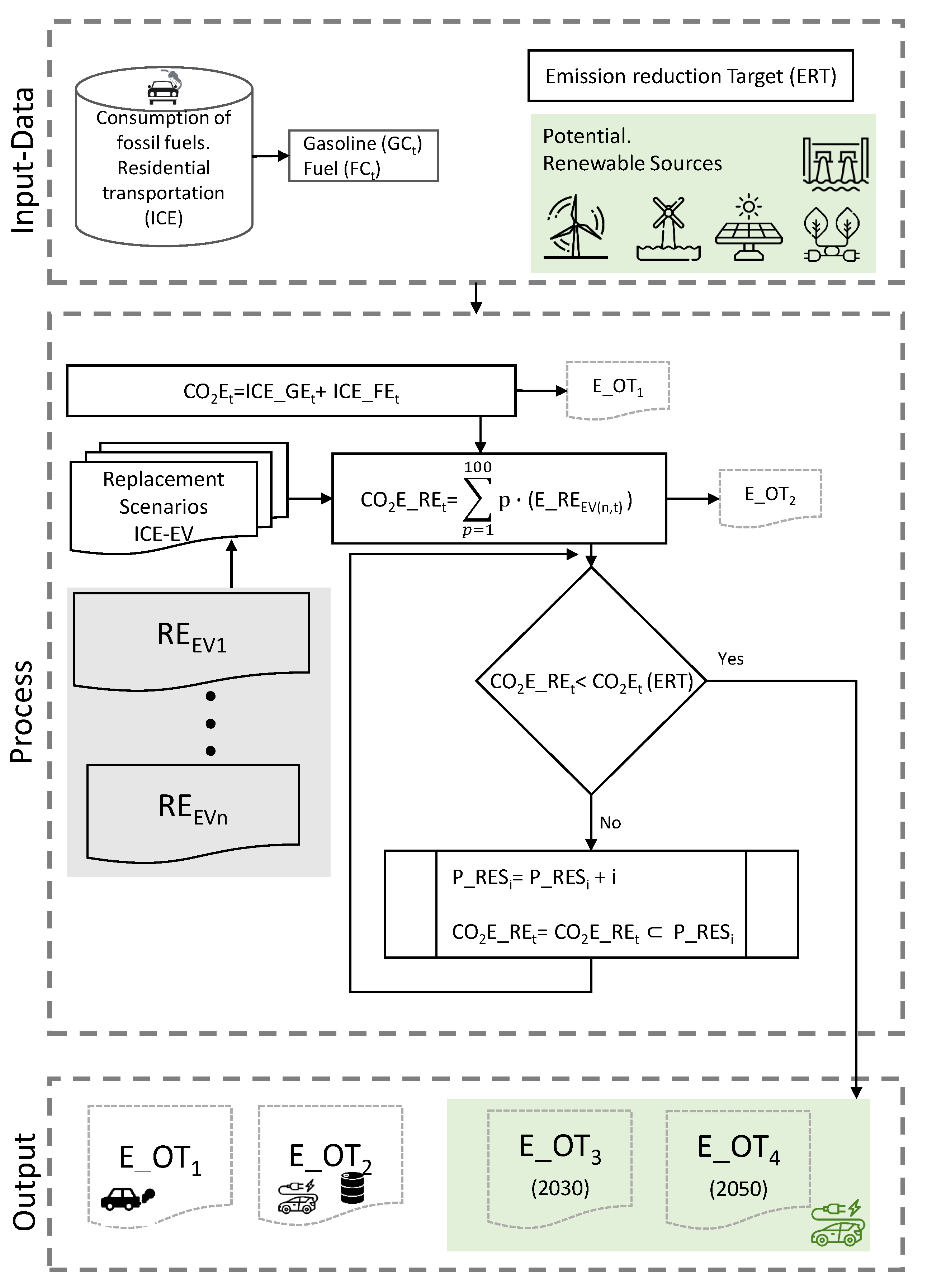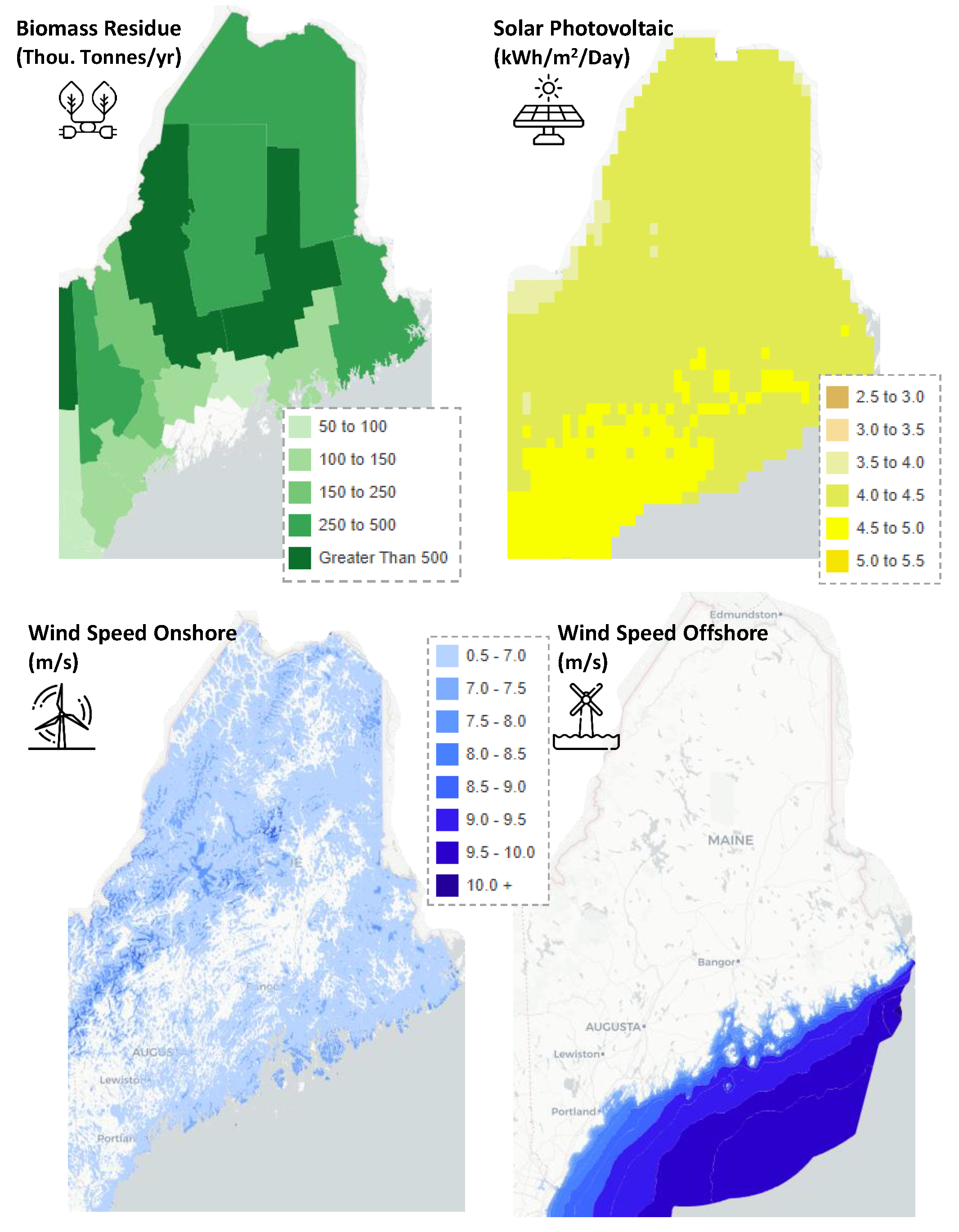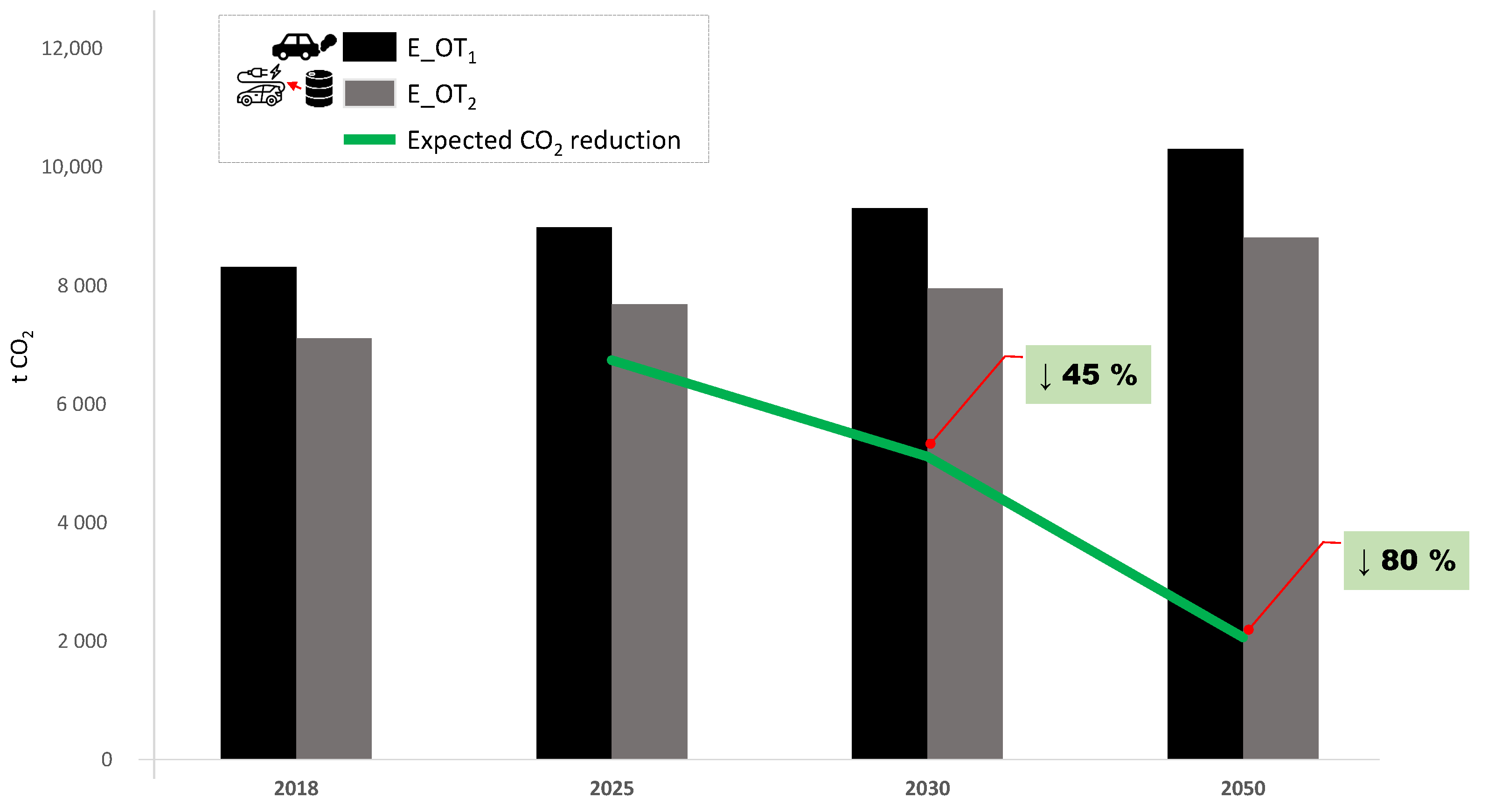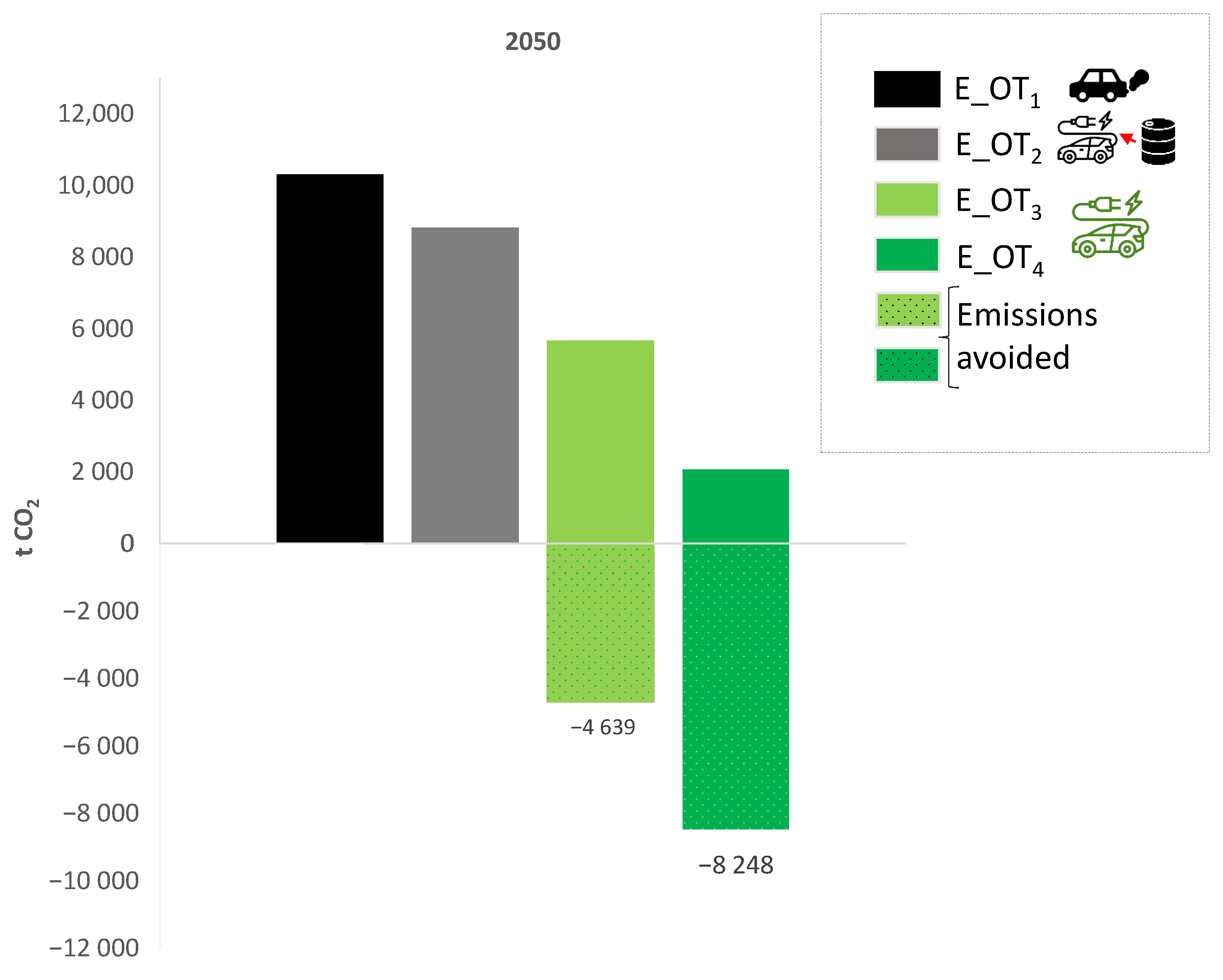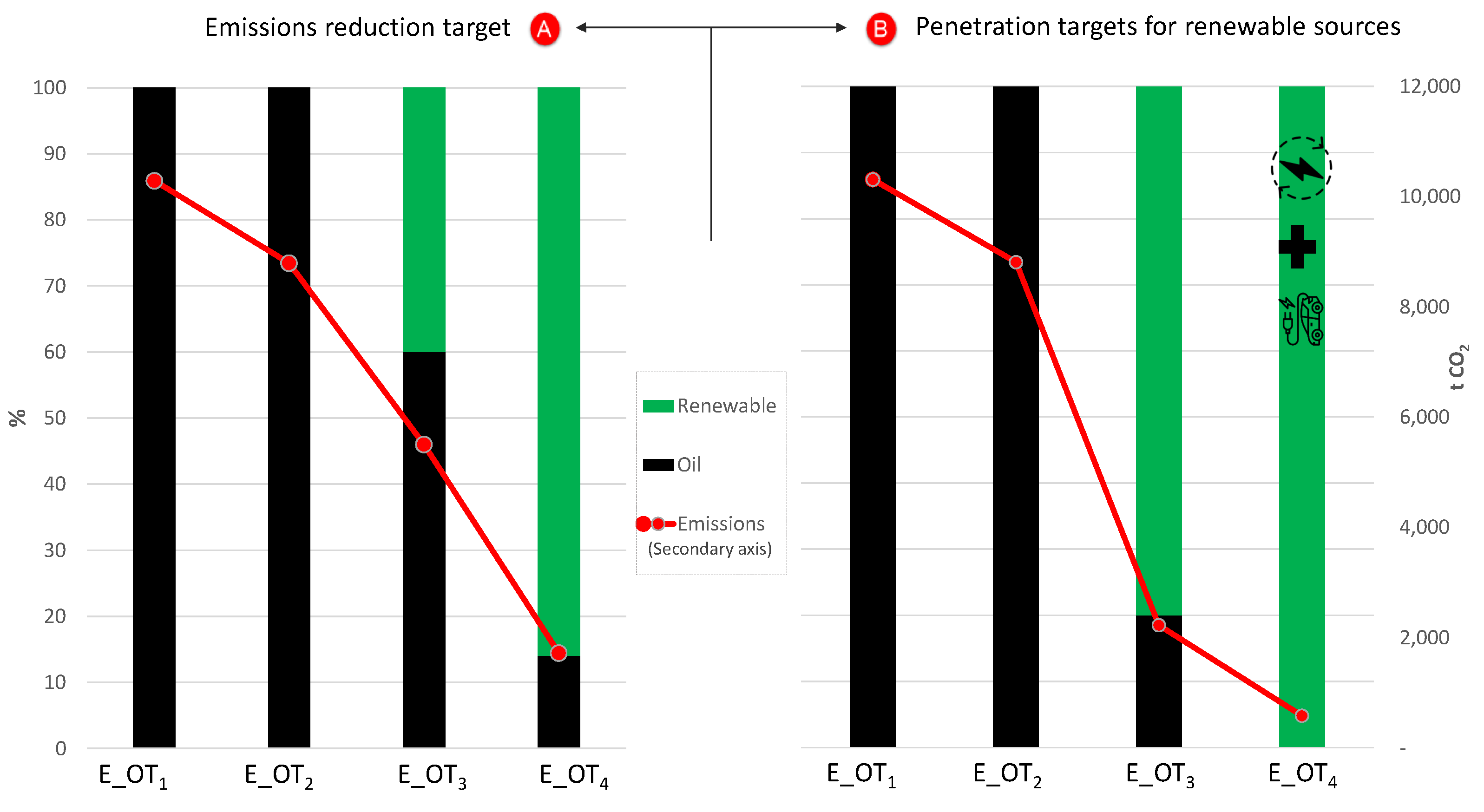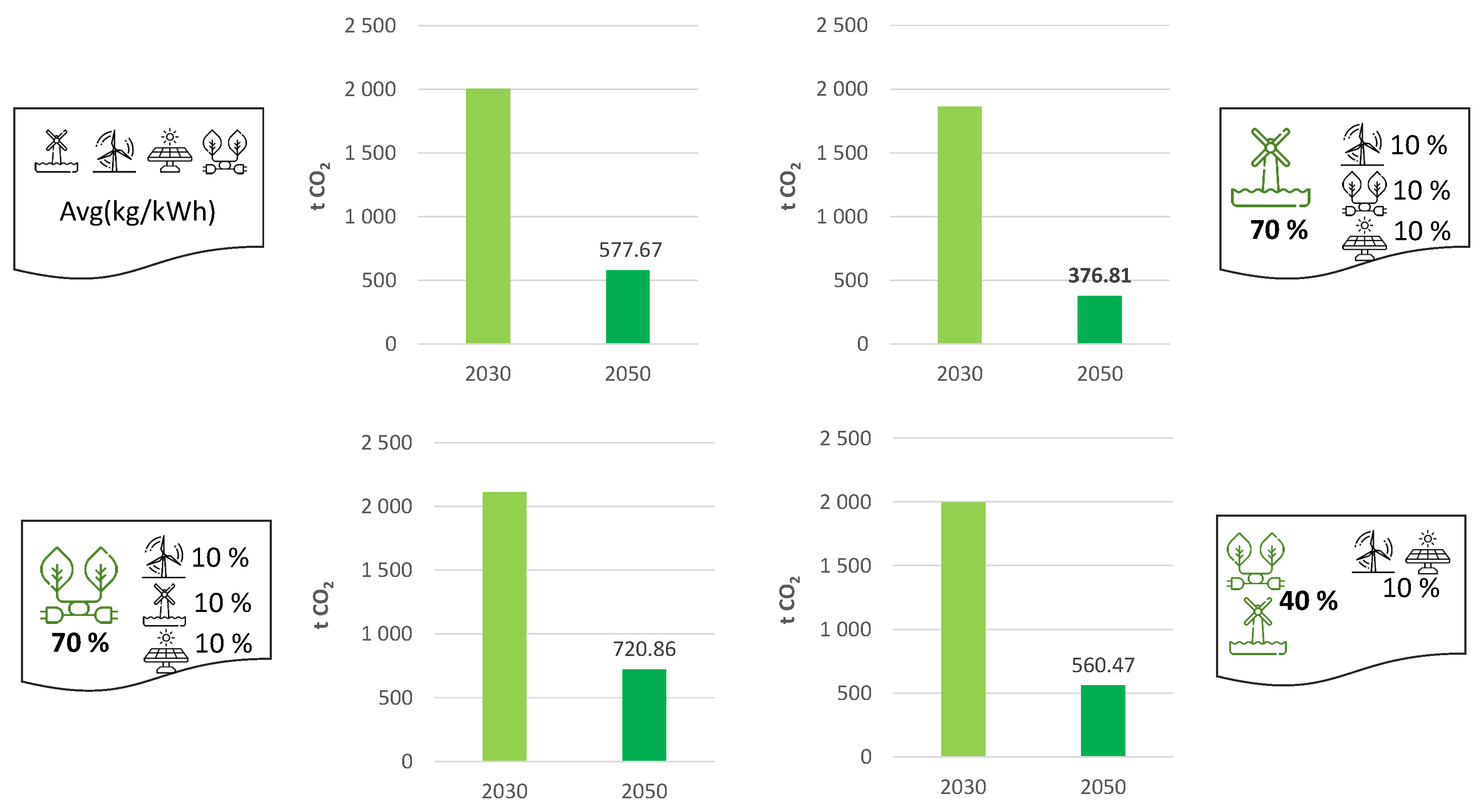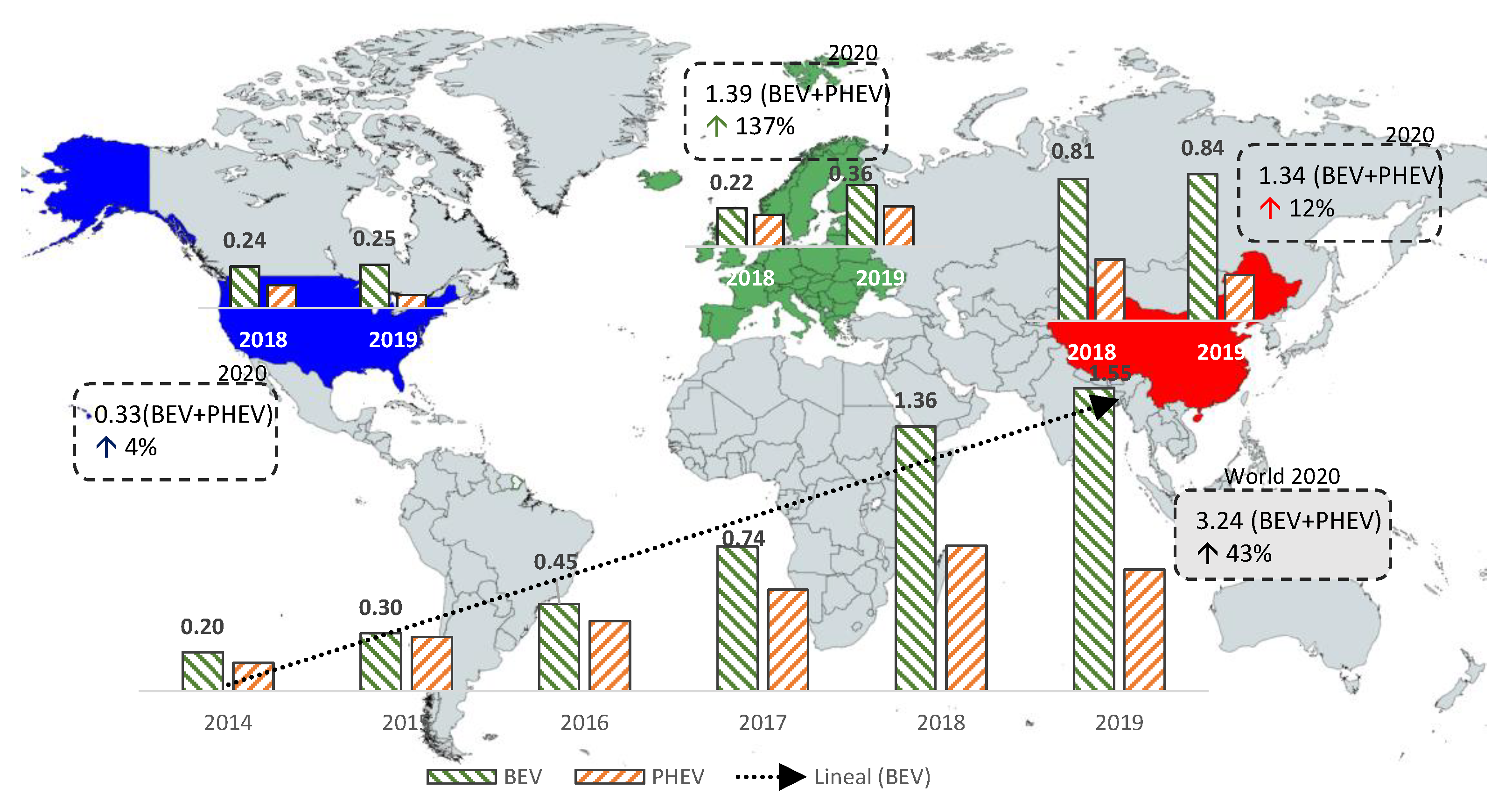1. Introduction
Renewable Energy Sources (RES) and energy efficiency strategies are the core elements of the energy transition [
1]. A systemic transition towards more efficient energy scenarios implies a strategically designed actions involving all policy levels—from local to global [
2]. A variety of challenges are thus identified, mainly due to the relevant population increase, limitation of fossil fuel reserves, lack of energy security, and both economic and urbanization growth [
3]. As an effort to reduce the impact of global warming, the world leaders have pledged the commitments to drastically reduce greenhouse emissions [
4]. Nevertheless, the increase in the population worldwide evolves exponentially and migration to urban areas increased by 53% from 1998 to 2018 [
5]. According to the United Nations [
6], the world population will reach 9700 million in 2050, of which 68% will live in urban areas. Subsequently, world energy consumption will rise nearly 50% between 2018 and 2050 [
7].
Cities have become critical icons to facilitate climate action, energy transition, and sustainability [
8,
9]. The significant concentration of population and the corresponding economic activity increasing commonly address major demand and dependence on transport services and supplies [
10]. Two negative factors for energy transition can be then clearly identified from the transport sector: higher use of fossil fuels and increased pollution. Actually, the transport sector is responsible for more than 20% of global greenhouse gas emission [
11]. This sector accounts for 26% of the total US greenhouse emissions and 23.20% of EU-28. The shares of pollutants range from 13.14% to 57.41%, and the transport sector is the main emitter for NO
[
12]. Therefore, it is one of the major challenges in reducing global greenhouse gas emissions [
13]. Different solutions and proposals can be found in the specific literature to make or advise on decisions in the transport sector [
14,
15]. Moreover, in recent proposals, the transport sector has been a part of models of 100% renewable energy systems, such as the European Union [
16] and the region of South East Europe [
17]. However, only 3.3% of the energy consumption of the transport sector currently has a renewable origin (3% from Biofuels and 0.3% from renewable electricity). Moreover, this sector accounts for the lowest percentage of participation in renewables [
18]. Therefore, in this context, an important way of mitigating climate change is the replacement of the current transport fleet with Electric Vehicles (EV) [
19]. The electrification of this sector will address a greater demand for energy integrated with renewables. According to Reference [
20], common research topics within the transport area include electric vehicles and the sustainable road transportation.
From 2014 to 2019, the sales of Plug-in Hybrid Electric Vehicle (PHEV) vehicles were increased 334%; and Battery-Electric Vehicles (BEV) sales 682%. In 2019, approximately 2.17 million EVs were sold globally, 832,101 EV more than 2018. In 2019, the European EV registrations were close to 550,000 units, in comparison to 300,000 units in 2018, accounting for an increase from to 3.5% of total car registrations [
21]. Today, the global fleet of EVs accounts to 7.2 million of cars. China leads the EV sales market: 1.11 millon EV in 2019—0.84 BEV and 0.26 PHEV, almost duplicate the sales of 2017 with more than 50% of world sales, a decrease of 5% compared to 2018. The United States is the second country in terms of sales, 0.33 millon EV in 2019—0.25 BEV and 0.08 PHEV, with a growth of 52% in comparison to 2017, a decrease of 11% compared to 2018. Preliminary sales data in 2020 are surprising, despite the current health emergency caused by COVID-19, PHEV + BEV sales increased 43% compared to 2019 with 3.24 million units. For the first time, Europe leads the ranking with nearly 1.4 million EVs displacing China. One hundred and thirty-seven percent is the increase in growth in Europe compared to 12% in China, and the United States with a 4% increase remains in third position; see
Figure 1.
In terms of EV models, and by considering the top-ten best-selling EVs in the world in 2019, there are eight BEVs accounting for 34.2% of the total, and two PHEV (4.65%). The ranking of the worldwide best-selling models is headed by the
‘Tesla Model 3’ (BEV) with a total world sales of 13.83% in 2019—300,080 units sold. Its technical characteristics give different power options [
24], ranging between 192 kW and 334 kW with an autonomy between 355 km and 500 km, and an average consumption around 16.09 KWh/100 km [
24]. The
‘BAIC EC-Series’ (BEV) is the second model, with 111,050 units sold representing 5.11% of the total global sales, mainly focused on the Chinese market. In third position, the
‘Nissan Leaf’ model with 69,870 units sold and 3.22% of the total amount. In this case, its main market is focused on Europe. In the preliminary data for 2020, the
‘TESLA Model 3’ remains leading the ranking, its sales triple the Chinese model in second position, a curious aspect is the disappearance of the PHEVs among the top 10, ratifying the upward trend of the BEVs. The top 10 begins to separate from the rest of the world, 70% of total sales are outside the ranking, compared to 61% in 2019.
Figure 2 summarizes the EV sale ranking.
With regard to the replacement of conventional vehicles by EV, Reference [
26] studied a comprehensive review of the replacement of conventional vehicles by EV and concludes that the battery electric vehicle (BEV) is considered a true zero-emission vehicle due to the lack of tailpipe emissions compared to other types of EV, but the savings in greenhouse gas (GHG) emissions from the EV is debatable when the energy required to charge the EV comes from traditional sources of fossil fuels, it also alludes to the technical, economic, and logistical barriers that stop the expansion. Szinai et al. [
27] estimate the integration of EV in the state of California, United States, by 2025. This analysis ensures that the fusion EV and renewables will help to decarbonize both transport and electricity sector simultaneously. Li et al. [
28] carried out a study of electric mobility in the Asia Southeast, involving the fleet of residential passengers, buses and trucks. This evaluation includes availability, applicability, acceptability, and affordability indicators, giving a final energy consumption and a major energy security. Raugei et al. [
29] affirm that the EV integration can reduce significantly the UK’s dependence on conventional primary energy sources. The analyzed key–metric is the demand for non-renewable energy, that could be reduced around 34% by EV in comparison to conventional vehicles. The mitigation of emissions, studied by Brice et al. [
30] in the state of Texas (United States), demonstrates the substantial reduction of greenhouse gases to be achieved by renewable integration into mix generation power systems. Vehicles powered by coal, natural gas, and renewables are compared to EVs, highlighting that EVs reduce significantly emissions and increase energy security.
Considering previous contributions aiming to decarbonize the residential transport sector, this work proposes an analysis of the ICE vehicles replacement by EV in the residential sector establishing the minimum penetration limits of renewables to fulfill the emission reduction objectives. The design and selection of potential EV scenarios is based on both economic and technological barriers of the sector.
Table 1 summarizes recent contributions related to the electrification of the transport sector and the targets/indicators considered in those works. This table also compares such indicators to the proposed multi-indicator analysis. A case study focused on the state of Maine (United States) is also included in the paper by considering 2030 and 2050 roadmaps. From the results, a maximum of 18% non-renewable power generation will be allowed in 2050 to reach the emission reduction targets by considering 100% conventional vehicle replacement. The main contributions of this study are thus:
The definition of a methodology by combining simultaneously three main indicators: (i) the Emission Reduction Objectives (ERT); (ii) the potential renewable energy source in the area (PoRES); and (iii) the Penetration Renewable Energy Goals (PERST).
The feasibility and suitability of the proposal to provide evaluation and strategy guidance in real situations is carried out by the authors with the state of Maine (USA) case study.
The EV substitution scenarios are merged with the EV efficiency indicators and the renewable/energy policies in a multi-target framework.
The rest of the paper is divided into the following sections:
Section 2 exposes the proposed analysis of EV integration from a multi-indicator perspective;
Section 3 evaluates the model in the state of Maine (United States); results are discussed in
Section 4 in terms of emission reduction, quantitative variability according to the objectives, and contributions from renewable sources; finally, conclusions are given in
Section 5.
2. Materials and Methods
An evaluation based on multi-indicators to analyze the impact of ICE replacement by EV in the energy transition is proposed and assessed, defining different replacement scenarios and renewable integration shares. The methodology is summarized in
Figure 3.
The initial stage is focused on gathering all data required as inputs of the analysis: (i) the fossil fuel energy consumption in the residential transport sector, whether of ICE gasoline or fuel vehicles for the base year of study ; (ii) the Emission Reduction Targets (ERT) of the study area for 2030 and 2050; and (iii) the potential of the different renewable energy sources available in the study area.
From the initial data, four possible scenarios are defined according to the corresponding emission reductions to be fulfilled in 2030 and 2050.
Table 2 describes such scenarios by considering the ICE replacement, as well as the RES integration into generation power system, accordingly. Firstly, the emissions (
) in the base year
t are estimated. Therefore, the global ICE emissions corresponding to vehicles powered by both gasoline (
) and fuel (
) are:
These emissions include the complete life cycle of the vehicle according to the energy flow in the Well–to–Wheel (WtW) process [
47]. This process can be divided into two estimations: (i) the Well-to-Tank (WtT) focused on determining the emissions in the extraction, transportation and processing processes of fuel; and (ii) the Tank-to-Wheel (TtW) aimed to determine the total emissions in the driving process [
48]. Subsequently, gasoline or fuel ICE vehicle emissions are determined according to:
and extrapolated to 2050 by following the scenario E_OT
.
The E_OT
scenario —ICE vehicle substituted by EV without RES integration, see
Table 2—, is designed with different EV penetration levels. Each study area can required different EV characteristics, depending on the specific conditions and facilities of such areas, which affect the behaviors and preferences of the users in terms of:
Power: What acceleration can the engine deliver? What speed can you keep?
Autonomy: How long can the vehicle travel without refueling? The energy density of gasoline and diesel is higher than batteries, providing greater ranges.
Fueling time: How much time is needed to recharge? The extended recharge time of the EV is longer than the refueling minutes of conventional vehicles.
Efficiency: How far can a vehicle travel to give a unit of fuel energy, measured in kilometers per liter for conventional vehicles?
The emissions are then calculated as follows,
where
p is the penetration percentage of the EV replacement scenarios,
n is the number of scenarios, and
are the emissions of each scenario according to
where
are kilometers traveled for a base year
t (km);
is the EV consumption for the
n-scenario (kWh/100 km); and
is the emission factor of the power generation units based on oil (kg CO
/kWh). Results from expression (
5) are then extrapolated to 2050 for the E_OT
scenario estimation.
An iterative process compares the
emissions of the E_OT
scenario to the emission reduction targets
. The renewable integration into the power generation mix (
) is increased to fulfill such emission targets:
. The emissions by considering the Renewable Energy Source (RES) participation (
) is then expressed as,
The methodology determines the maximum non-renewable power generation allowed to fulfill the emission reduction targets
. The corresponding participation of renewable energy sources
are also considered in both E_OT
and E_OT
scenarios for 2030 and 2050.
where
is the distance traveled for base year (km),
is the EV consumption for the
n-scenario (kWh/100 km), and
is the power system emission factor generated with renewable energy source (
).
Finally,
Table 3 summarizes the output indicators for the different scenarios. These indicators can be subsequently used for further analysis.
3. Case Study. Renewable Energy Source Potential
The selected study area is the state of Maine (United States). It belongs to the New England region, located in the northeast region of the country; see
Figure 4A. The total energy consumption of this state was 328 Trillion–Btu in 2018. The sector with the highest energy consumption was the transportation sector, 32.5%—106.7 Trillion Btu, followed by the industrial, residential, and commercial sectors, with 28.1%, 24.9%, and 14.5%, respectively, of the total energy demand [
49]; see
Figure 4B. Consumption by sources shows the high use of oil, 174.9 Trillion Btu—53.3% of the total; see
Figure 4C.
In line with other countries, the United States of America has also promoted different initiatives to reduce greenhouse emissions and fossil fuel dependency. Indeed, most of state governments have adopted different policies mainly focused on reducing the carbon intensity and diversifying the mix of generation sources with a greater percentage of renewable energy sources [
51]. Indeed, policies established by the state of Maine are currently focused on the decarbonization of the economy, integration and promotion of renewable energies, and challenges of energy transition. In 2019, the Renewables Portfolio Standard (RPS) targets were recently updated with the statewide target of 100% renewable by 2050 [
52]. The proposed methodology is thus assessed under this specific energy and policy scenario.
Energy consumption data of the transportation sector for the state of Maine can be found in [
50], being the State Energy Data System (SEDS) dependent on the U.S. Energy Information Administration (U.S. EIA).
Table 4 gives the disaggregated data in British thermal units (Btu). Gasoline is the most used fuel in the state of Maine, accounting for 68.13%, followed by Distillate Fuel Oil—mainly used in buses, railroad locomotives, trucks, etc. Private transportation is dominated by internal combustion vehicles powered by gasoline. In 2018, gasoline consumption was 75,509
Billion Btu, being equivalent to 22,130 converted into electric units according to
The emission reduction targets for the state of Maine are 45% and 80% for 2030 and 2050, respectively. The Governor-led Maine state climate council developed action plans to reduce Maine’s greenhouse gas emissions [
53].
Figure 5 depicts the renewable source potential; mainly based on biomass, photovoltaic solar, and wind (onshore and offshore). This RES potential is very relevant and, today, the Maine energy mix is classified as robust [
54], as 40.48% of the total energy consumption comes from renewables—with biomass standing out 67.46% and accounting for 31,710 GWh. Wind power is expected to install 8 GW of power capacity by 2030, including 5 GW wind offshore [
53]. In total, the coasts of Maine account for 156 GW offshore wind power estimated capacity [
55].
The emissions of vehicles powered by fossil fuels mainly depend on the type of fuel: gasoline or diesel. Shin et al. [
57] affirm that consumers recognize diesel type as clean diesel, having low emissions compared with gasoline. Woo et al. [
58] establishes that WtW gasoline emissivity is 2778.2 gCO
/L (WtT: 2314.4 gCO
/L and TtW: 463.8 gCO
/L). Considering that the residential transport of the study area is mainly based on gasoline, we calculate the emissions for the base year (2018) and extrapolate until 2050, according to the expected population increase [
59]. Results of the scenario
are summarized in
Table A1 (
Appendix A). As was previously discussed, the EV scenarios to replace ICEV vehicles include an analysis of economic and technological barriers. In this way, the state of Maine applies instant rebates [
60] in the purchase of a group of EVs, which are included in each scenario. Three categories are identified according to the EV autonomy: >300 miles, between 300 and 225 miles, and less than 225, with 50%, 30%, and 20% penetration, respectively; see
Table 5.
Table A4 summarizes the EV data sheet.

